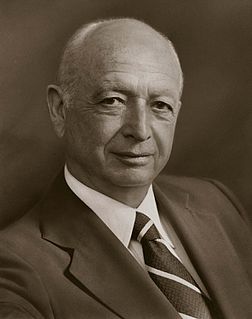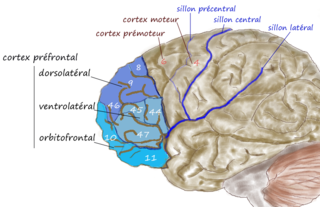
A cochlear implant (CI) is a surgically implanted neuroprosthesis that provides a person who has bilateral moderate-to-profound sensorineural hearing loss with sound perception and an opportunity with therapy for improved speech understanding in both quiet and noisy environments. A CI bypasses acoustic hearing by direct electrical stimulation of the auditory nerve. Through everyday listening and auditory training, cochlear implants allow both children and adults to learn to interpret those signals as speech and sound.

The auditory cortex is the part of the temporal lobe that processes auditory information in humans and many other vertebrates. It is a part of the auditory system, performing basic and higher functions in hearing, such as possible relations to language switching. It is located bilaterally, roughly at the upper sides of the temporal lobes – in humans, curving down and onto the medial surface, on the superior temporal plane, within the lateral sulcus and comprising parts of the transverse temporal gyri, and the superior temporal gyrus, including the planum polare and planum temporale.
Unilateral hearing loss (UHL) is a type of hearing impairment where there is normal hearing in one ear and impaired hearing in the other ear.

Otology is a branch of medicine which studies normal and pathological anatomy and physiology of the ear as well as their diseases, diagnosis and treatment. Otologic surgery generally refers to surgery of the middle ear and mastoid related to chronic otitis media, such as tympanoplasty, or ear drum surgery, ossiculoplasty, or surgery of the hearing bones, and mastoidectomy. Otology also includes surgical treatment of conductive hearing loss, such as stapedectomy surgery for otosclerosis.
Neuroprosthetics is a discipline related to neuroscience and biomedical engineering concerned with developing neural prostheses. They are sometimes contrasted with a brain–computer interface, which connects the brain to a computer rather than a device meant to replace missing biological functionality.

Graeme Milbourne Clark AC is an Australian Professor of Otolaryngology at the University of Melbourne. His work in ENT surgery, electronics and speech science contributed towards the development of the multiple-channel cochlear implant. and his invention was later produced and sold by Cochlear Limited.

The House Institute Foundation (HIF), formerly the House Ear Institute, is a non-profit 501(c)(3) organization, based in Los Angeles, California, and dedicated to advancing hearing science through research, education, and global hearing health to improve quality of life.
Michael Matthias Merzenich is a professor emeritus neuroscientist at the University of California, San Francisco. His contributions to the field are numerous. He took the sensory cortex maps developed by his predecessors and refined them using dense micro-electrode mapping techniques. Using this, he definitively showed there to be multiple somatotopic maps of the body in the postcentral sulcus, and multiple tonotopic maps of the acoustic inputs in the superior temporal plane.

The dorsolateral prefrontal cortex is an area in the prefrontal cortex of the brain of humans and other primates. It is one of the most recently derived parts of the human brain. It undergoes a prolonged period of maturation which lasts until adulthood. The DLPFC is not an anatomical structure, but rather a functional one. It lies in the middle frontal gyrus of humans. In macaque monkeys, it is around the principal sulcus. Other sources consider that DLPFC is attributed anatomically to BA 9 and 46 and BA 8, 9 and 10.
A mastoidectomy is a procedure performed to remove the mastoid air cells, air bubbles in the skull, near the inner ears. This can be done as part of treatment for mastoiditis, chronic suppurative otitis media or cholesteatoma. In addition, it is sometimes performed as part of other procedures or for access to the middle ear. There are classically 5 different types of mastoidectomy:
Neurotology or neuro-otology is a subspecialty of otolaryngology—head and neck surgery, also known as ENT medicine. Neuro-otology is closely related to otology, clinical neurology and neurosurgery.

William Fouts House was an American otologist, physician and medical researcher who developed and invented the cochlear implant. The cochlear implant is considered to be the first invention to restore not just the sense of hearing, but any of the absent five senses in humans. Dr. House also pioneered approaches to the lateral skull base for removal of tumors, and is considered "the Father of Neurotology."
The dorsal nexus is an area within the dorsal medial prefrontal cortex that serves as an intersection point for multiple brain networks. Research suggests it plays a role in the maintenance and manipulation of information, as well as supporting the control of cognitive functions such as behavior, memory, and conflict resolution. Abnormally increased connectivity between these networks through the Dorsal Nexus has been associated with certain types of depression. The activity generated by this abnormally high level of connectivity during a depressive state can be identified through Magnetic resonance imaging (MRI) and Positron emission tomography (PET).
Milind Vasant Kirtane is an Indian otorhinolaryngologist, reported to have performed the first cochlear implant surgery in Mumbai. The Government of India honoured him, in 2014, with the award of Padma Shri, the fourth highest civilian award, for his contributions to the field of medicine.
Thomas J. Balkany, M.D. is an American ear surgeon, otolaryngologist and neurotologist specializing in cochlear implantation. He is the Hotchkiss Endowment Distinguished Professor and Chairman Emeritus in the Department of Otolaryngology and Professor of Neurological Surgery and Pediatrics at the University of Miami Miller School of Medicine. Additionally, he is a fellow of the American Academy of Otolaryngology–Head and Neck Surgery, the American College of Surgeons and the American Academy of Pediatrics.

Mohan Kameswaran is an Indian otorhinolaryngologist, medical academic and the founder of MERF Institute of Speech and Hearing, a Chennai-based institution providing advanced training in audiology and speech-language pathology. He is one of the pioneers of cochlear implant surgery in India and a visiting professor at Rajah Muthiah Medical College of the Annamalai University and Sri Ramachandra Medical College and Research Institute, Chennai. He has many firsts to his credit such as the performance of the first auditory brain stem implantation surgery in South and South East Asia, the first pediatric brain stem implantation surgery in Asia, the first totally implantable hearing device surgery in Asia Pacific region, and the first to introduce KTP/532 laser-assisted ENT surgery in India. The Government of India awarded him the fourth highest civilian honour of the Padma Shri, in 2006, for his contributions to Indian medicine.
A cortical implant is a subset of neuroprosthetics that is in direct connection with the cerebral cortex of the brain. By directly interfacing with different regions of the cortex, the cortical implant can provide stimulation to an immediate area and provide different benefits, depending on its design and placement. A typical cortical implant is an implantable microelectrode array, which is a small device through which a neural signal can be received or transmitted.
John K. Niparko was an American surgeon, scientist and otolaryngologist who specialized in cochlear implants. Niparko edited and wrote several chapters of Cochlear Implants: Principles & Practices.
Neuromorality is an emerging field of neuroscience that studies the connection between morality and neuronal function. Scientists use fMRI and psychological assessment together to investigate the neural basis of moral cognition and behavior. Evidence shows that the central hub of morality is the prefrontal cortex guiding activity to other nodes of the neuromoral network. A spectrum of functional characteristics within this network to give rise to both altruistic and psychopathological behavior. Evidence from the investigation of neuromorality has applications in both clinical neuropsychiatry and forensic neuropsychiatry.
fMRI lie detection is a field of lie detection using Functional magnetic resonance imaging (fMRI). fMRI looks to the central nervous system to compare time and topography of activity in the brain for lie detection. While a polygraph detects anxiety-induced changes in activity in the peripheral nervous system, fMRI purportedly measures blood flow to areas of the brain involved in deception.








